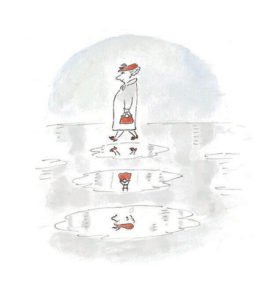There has been an unfortunate rash of deaths in the comics world lately.
After The Daily Cartoonist’s initial reports other memorials and tributes have appeared.
Here is a collection of those eulogies.
Jean-Jacques Sempé, the French cartoonist known in America for children’s book illustrations and for covers for The New Yorker portraying tiny, gentle people with big noses at poignant moments, often dwarfed by monumental backgrounds, died on Thursday. He was 89.
It was timeless storytelling without words, a kind of pictorial haiku, the droll whimsies of an illustrator who never attended art school but who, for a half-century at the drawing board, had bypassed life’s meanspirited realities for a mythical world of mischievous schoolboys, daydreamers, nosy neighbors, holidaymakers and swooning lovers.
The passing of Jean-Jacques Sempé made news around the world,
here is The New York Times obituary for the renowned cartoonist.
I don’t remember when I discovered Sempé’s drawings. Is it reading Petit Nicolas? Discovering his albums Rien n’est simple or Tout se complique?
Impossible to answer as I seem to have always known them.
I must admit that Jean-Jacque Sempé sits at the top of my pantheon of cartoonists.
Guy Badeaux (‘Bado’) considers one of his cartooning deities.
The New York Times, also yesterday, published an obituary for Paul Coker, Jr.
Paul Coker, a cartoonist who was best known for using monsters to parody clichés in Mad magazine over many decades and for creating the look of animated television characters, like Frosty the Snowman, died on July 23 at his home in Santa Fe, N.M. He was 93
“Paul was capable of whimsical but beautiful artwork that always had a bit of subversion to it,” John Ficarra, a former Mad editor, said in a phone interview. “He did phenomenal pen-and-ink work, and as he grew older he learned to simplify his work without losing its sparkle and charm.”
The Comics Journal posted an obituary for comic book editor and writer Sid Jacobson.
He is owed a debt of gratitude by fans of Harvey Comics from the 1950s through the 1990s, Marvel Comics’ Star line in the 1980s, approximately 300 pop songs of the 1960s, the Johnny Cypher in Dimension Zero animated series of the late 1960s, and 21st century graphic nonfiction such as The 9/11 Report: A Graphic Adaptation. His storytelling imagination encompassed teenage love songs and the childhood innocence of Harvey’s comics fables for kids, as well as the realities of Jewish history and modern bigotry and terrorism.
Harvey Comics historian Mark Arnold wrote the obit for TCJ.
Beloved author/illustrator/cartoonist Raymond Briggs brought a flood of tributes.
The Guardian followed up their obituary with a gathering of memories.
The beloved writer and illustrator of the Snowman and Father Christmas has died. Here, leading contemporaries and Guardian readers pay tribute.
Perhaps the most remarkable, final achievement with which we can credit author and artist Raymond Briggs, creator of classic comic stories such as Fungus the Bogeyman and The Snowman, is the coverage of his passing across British national media, and beyond. It’s extremely rare for a graphic novelist – and yes, like it or not, he was one, and one of the first in Britain – to attract such deserved attention.
Tributes included obituaries in newspapers as diverse as the BBC, the Daily Mail, The Guardian, The Independent, the Daily Telegraph and more, in addition to tributes on specialist comic and genre sites.
Down The Tubes also presents
“Tributes to Raymond Briggs from comic creators, authors, and a guide to his books.”

Cartoonist Steve Bright paid tribute to Briggs with a marvellous illustration.
“Amidst the sadness, this was a pure joy to draw,” he said.”I make no apology for any
over-sentimentality, since he was the master of sentimentality in all he created.”
The Washington Post’s obituary for Raymond Briggs.
Briggs’s publisher praised him for inspiring “generations of creators of picture books, graphic novels, and animations.” Francesca Dow, managing director of Penguin Random House Children’s Books, said the death of Mr. Briggs leaves a “big hole” in the industry.
Raymond Briggs, so effective at conveying a sense of innocence & wonder, as well as pure terror. What a writer pic.twitter.com/peeUIUNHOm — Toby Earle
The Poke features the editorial cartooning of Morten Morland for The Times and the response.
Usually described as a children’s author, his illustrated books often dealt with adult themes, such as dissatisfaction with life, the difficulties of the generational divide, mental health and, in his post-apocalyptic masterpiece When the Wind Blows, the human cost of nuclear warfare.
It was this work that formed the basis for the Times’ incredibly apt tribute.
Morten Morland’s cartoon, featuring When the Wind Blows characters Jim and Hilda Bloggs, expresses the utter bleakness of the fuel crisis in a way that he would surely have appreciated.





